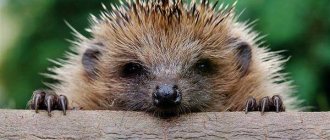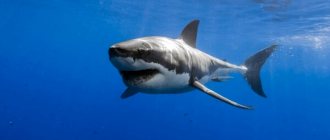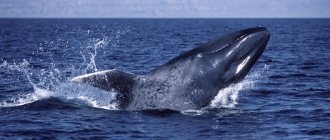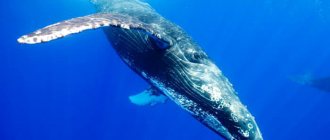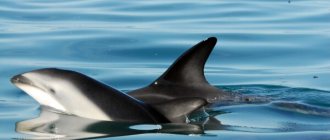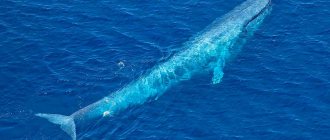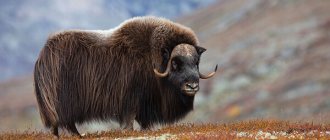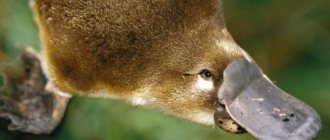- Wild animals
- >>
- Mammals
The bowhead whale spends its entire life in cold polar waters. With its blowhole it breaks through 30 cm of ice. Submersible underwater for 40 minutes and to a depth of 3.5 km. Claims to be the longest living mammal, with some individuals living for over 100 years! The Whale Fish entered folklore as the prototype of the character Miracle Yudo. It's all about the bowhead whale.
Description
The bowhead whale is the second largest whale in the world, second only to the blue whale. Female bowhead whales have an average body length of 16 to 18 meters, and males from 14 to 17 meters. The body weight of a polar whale varies from 75 to 100 tons. The lower jaw is U-shaped and covered with light spots that contrast with the dark body color of the animal. The mouth of the bowhead whale is the largest of all cetaceans and contains 300 baleen plates 300-450 centimeters long. The skull makes up almost one third of the total body length. The pectoral fin is not large relative to the size of the whale and does not exceed 200 centimeters in length. The bowhead whale has an impressive layer of subcutaneous fat, about 60 centimeters thick.
Kola Peninsula
Water area of the Barents Sea
To feast on fish in May, during the spawning season, cod, sperm whales and minke whales swim into the waters of the Barents Sea. This is one of the most accessible whale watching destinations in Russia.
Three-day tours to the Kola Peninsula to whale feeding areas are organized by several travel companies, including Russia Discover. The program includes a trip to the island of Kildin, fishing, a visit to Teriberka, where the action of the film “Leviathan” took place, as well as a tour of Murmansk and a visit to the nuclear icebreaker “Lenin”. The journey takes place by ship and partly by jeep.
How to see the tundra: ideas and routes
Sperm whales are easily recognized by their characteristic appearance; they have a huge rectangular head, which contains the so-called spermaceti sac. According to one version, the whale uses this device for echolocation. According to another version, the bag plays the role of a swim bladder and helps the whale when diving and rising from the depths. Minke whales can be easily identified by their dozens of characteristic stripes and folds. They stretch along the lower part of the body from the mouth to the navel.
Where: open sea off the coast of the Kola Peninsula, Anikeev and Kildin islands.
Whales: sperm whale, minke whale. Less common are the bowhead whale, narwhal, blue whale and highbrow bottlenose.
Season: May.
Cost: three-day tour - from 44 thousand rubles per person. On the first night, guests spend the night on the ship in a cabin. The rest of the time - in mini-hotels. An additional fee is paid for a flight to Murmansk (round trip from Moscow - about eight thousand rubles).
Area
Polar whales once inhabited the oceans throughout the Earth's northern hemisphere. Over the past hundred years, the population of bowhead whales has been significantly reduced. Currently, they are found in the waters of Spitsbergen, Davis Strait, Hudson Bay, as well as the Sea of Okhotsk and Bering Sea. Bowhead whales rarely swim below 45 degrees north latitude.
Population today
For thousands of years, people have hunted whales. By the beginning of the 20th century, the extermination of bowhead whales had reached colossal proportions, and they found themselves in the category of an endangered species.
The hunting of bowhead whales was banned back in 1935. In the seventies of the last century, it was listed in the Red Book as an endangered species. The population is at the stage of extinction. A herd of bowhead whales in the Bering-Chukchi region was classified as a category 3 rarity.
Scientists have determined that there are only 11,000 bowhead whales left today.
Reproduction
Male polar whales attract females using songs. Mating for bowhead whales usually occurs in late winter and early spring. After which, the spring migration begins, and the birth of cubs occurs from April to June, with most births occurring in May. The duration of pregnancy varies from 12 to 16 months. The bowhead whale reaches sexual maturity at the age of 20 years. At this time, their body length is 12.3-14.2 m. Females, as a rule, become sexually mature earlier and by this time their body length is 1-2 m longer than that of males. In rare cases, pseudohermaphroditism is observed, when females develop male genital organs.
The average body length of a bowhead whale at the time of birth is 4.25-5.25 m. The calves grow 1.5 cm per day. Feeding on mother's milk lasts 9-15 months, then the growth rate decreases. After giving birth, polar whales split into groups to migrate. Cubs and mothers are in the front group. Perhaps this is to allow them to feed first. For the most part, females are responsible for raising the young, although there have been cases where small groups of whales have been encountered, including a mature male, female and calf.
Polar bear
It is also called a polar or northern bear. It is a close relative of the brown bear. This is one of the largest terrestrial representatives of mammals of the order of carnivores: its length reaches 3 m, weight - up to 1 ton. Female polar bears are noticeably smaller than males: they usually weigh 200-300 kg. The polar bear is distinguished from its other brothers by its white fur, long neck and flat head.
Lifespan
The bowhead whale has an amazing lifespan. The average age of animals killed during whale hunts is estimated to be 60-70 years, based on analysis of changes in the nucleus of the eye. However, several individuals have been caught with ancient stone harpoons embedded in their flesh, and studies of the eye nuclei have led to estimates that these whales have a lifespan of up to 200 years, making bowhead whales the record holder for the longest lifespan among mammals. There are few diseases that threaten polar whales, and this factor not least affects the average life expectancy.
Interesting facts about the animal
Despite the short lifespan of endangered marine animals, some individuals can live up to 100 years. More than two dozen such cases have already been registered. Also, this species of sea giants is considered the most cowardly of its kind. When the slightest threat appears, they go underwater to a depth of 200 meters.
Another interesting fact is that on Itygran Island, in Chukotka, there is a site of accumulation of bowhead whale skeletons. Scientists count the remains of more than 50 individuals. Therefore, among the locals, the alley of five-meter bones is considered a sanctuary.
Still have questions or have something to add? Then write to us about it in the comments, this will make the material more useful, complete and accurate.
Nutrition
The polar whale belongs to the suborder of baleen whales. Representatives of this group of whales feed by filtering water through the baleen, after which, using the tongue, they swallow the organisms that have settled on the baleen. The diet of the bowhead whale includes crustaceans, zooplankton and in some cases benthic organisms. Copepods are not an important source of food for young individuals, but with age their share in the whale's diet steadily increases. In one minute, the bowhead whale is able to filter out about 50,000 small organisms. Sometimes, polar whales form groups of up to fourteen individuals, creating V-shaped pods. In such a formation they migrate and filter water.
Types of whales. Reference
The order Cetacea is divided into two well-differentiated suborders: baleen whales (Mysticeti) and toothed whales (Odontoceti). These suborders differ from each other in both morphological characteristics and behavior.
Baleen whales (suborder Mysticeti) got their name because of the so-called long horny plates. whalebone, located in their mouth instead of teeth.
The gray whale (Eschrichtius robustus) is considered one of the oldest mammals - the age of the species is about 30 million years. The length of the female does not exceed 15 meters, and the male – 14.6 meters. The mass of this whale is 20-35 tons. The gray whale usually has a smooth belly, with only 2-4 deep grooves on the throat, diverging backwards at a slight angle. On the back, instead of a fin, there is a faintly visible hump. The head is small, 4.5-5 times shorter than the body length, compressed laterally. There are two regularly migratory populations of gray whales: the Okhotsk-Korean and the Chukchi-California. The first is almost exterminated; winters and breeds near Korea and Southern Japan, and fattens in the summer in the Sea of Okhotsk. The second winters off the coast of the California Peninsula, and in the summer fattens in the Bering and Chukchi Seas, occasionally penetrating into the East Siberian Sea to Nolde Bay and east to Cape Barrow.
The blue whale (Balaenoptera musculus) is the largest animal that has ever existed on Earth. The female is always larger than the male and reaches a length of 30 m with a mass of more than 100 tons. The color is not blue, but bluish-gray with irregularly shaped silver-gray spots. The belly is sometimes yellowish due to microscopic algae clinging to it. It feeds on planktonic crustaceans, absorbing up to a ton of food for each “meal”. The blue whale is distributed from the Chukchi Sea, Greenland, Spitsbergen and Novaya Zemlya to the ice of Antarctica. Winters in warm waters: in the northern hemisphere - at the latitudes of Southern Japan, Taiwan, California, Mexico, North Africa, the Caribbean Sea; in the southern hemisphere - at the latitudes of Australia, Peru, Ecuador, South Africa, Madagascar. The blue whale spends its summer in the waters of the Antarctic, North Atlantic, Bering and Chukchi Seas. The blue whale is listed in the Red Book of Russia and the International Red Book.
The humpback whale, or humpback whale (Megaptera novaeangliae), is a large animal with a dense, shortened body; the back and sides are blackish, and the belly color varies from black or mottled to white. The maximum length is approximately 15 meters. An individual 14 meters long can weigh over 40 tons. Humpback whales can be found in all oceans. Its herds migrate with the changing seasons and depending on the amount of food, spending the winter in tropical waters. It feeds on planktonic crustaceans and small fish. Humpback whales often jump completely out of the water in an upright position and fall back with a deafening splash. However, this species is especially famous for the extensive repertoire of sounds it makes; it was nicknamed “Humpback” by whalers for the way it arches its back while “singing.”
The fin whale (Balaenoptera physalus), also called the herring whale, is a large animal with a wedge-shaped head, a long slender body and a high dorsal fin set far back. The body is grayish-brown above and white below. The species is distributed in all oceans and migrates in herds ranging from a few to more than 100 individuals. Migrations are seasonal: the fin whale spends the summer in the Arctic and Antarctic, and the winter in warmer seas. It feeds mainly on planktonic crustaceans, less often on schooling fish, such as herring.
The sei whale (Balaenoptera borealis) is less slender than the fin whale, its body is relatively thicker, its pectoral fins are shorter, and the dorsal fin is larger and more strongly pushed forward - towards the beginning of the rear third of the animal's body. The color of the back is dark gray, the sides are slightly light, and on the belly it is variable, varying from gray to partially white (but the entire underside is never white, like the fin whale). The sei whale is as widespread as the fin whale, but in the Arctic and Antarctic it usually avoids ice, appears there later than large species of minke whales, and is less regular in its migrations. The sei whale is listed in the Red Book of Russia and the International Red Book.
The minke whale (Balaenoptera acutorostrata) is very similar in white belly and body shape to fin whale calves, but appears thicker and has different body proportions (its length is 5-5.5 times its maximum thickness). Clearly distinguished by white, low (no higher than 25 centimeters) whisker plates, 270-330 in each row. The minke whale is distributed from the ice of the Arctic to the ice of the Antarctic. Most rare in the tropical zone. The species is listed in the International Red Book. The bowhead or polar whale (Balaena mysticetus) reaches a size of 21 meters and a weight of up to 150 tons. Its huge head occupies a third of the body and is separated from the body by a clearly visible neck. The general coloration of adults is dark, sometimes with a white throat; in immatures it is grayish-dark. The skin on the body is smooth, without horny growths and bumps, and is not overgrown with barnacle shells. Living in the high latitudes of the Arctic, the bowhead whale perfectly navigates among floating ice and is capable of punching holes with its back in ice 20-30 centimeters thick. Once upon a time, there were three herds in the circumpolar range: Svalbard, West Greenland and Bering-Chukchi. At present, the first two herds have been almost completely exterminated, and the third has survived only in negligible quantities. Whales stay solitary and only very rarely gather several individuals together. Their main food is tiny calanus crustaceans (3-4 millimeters), and sometimes pteropods. The bowhead whale is listed in the Red Book of Russia and the International Red Book. The southern whale (Eubalaena glacialis) differs from the bowhead whale in its smaller head, which occupies about 1/4 of the body length and is not separated by a cervical interception, a more complex bend of the mouth (in the form of the Latin letter “S”, laid on its side) and the presence of a snout at the top one or more horny growths. The body color is usually entirely black, or, less commonly, white on the belly and sides, or piebald. These whales are common in temperate waters.
There are three known subspecies of the southern right whale: the Biscay whale (Eg glacialis), which lives in the North Atlantic, the Japanese whale (Eg japonica) from the North Pacific Ocean, and the Australian whale (Eg australis) from the Southern Hemisphere. Some zoologists consider them to be separate species. The number of all three is very small due to centuries of barbaric fishing. The southern whale is listed in the Red Book of Russia and the International Red Book.
The pygmy whale (Neobalaena marginata) is the smallest and rarest of the baleen whales. It does not exceed 6 meters in length. The lifestyle of this rare whale has not been studied, the total number is unknown. Lives alone, mainly in the waters surrounding southern Australia and New Zealand, and apparently does not migrate far.
The suborder of toothed whales (Odontoceti) includes cetaceans with teeth, either on the front of the lower jaw or on both jaws (in some species the teeth are not functional). Males are usually larger than females. The main food of almost all species is fish or squid. Unlike baleen whales, toothed whales have an unpaired nostril.
The sperm whale (Physeter catodon) is the largest toothed whale: males reach 20 meters, and females - 15 meters. It is capable of diving to a depth of over 1.5 kilometers, remaining there for an hour, and then emerging without, apparently, experiencing any special overloads. The head, constituting a third of the total body length, is blunt in front and can be used as a huge battering ram; in the past, wooden whaling ships were damaged by such attacks. The long (5.5 meters) but narrow lower jaw bears from 8 to 36 pairs of strong conical teeth, each of which weighs approximately 1 kilogram. There are no more than 1–3 pairs of them on the upper jaw, and they are non-functional. The sperm whale can be recognized by its short, wide fountain directed forward and upward. Its main food is squid and cuttlefish, which it catches at the bottom using its long jaws. Adult sperm whales consume up to a ton of food per day. Animals migrate in herds of thousands.
Males are distributed over a larger area than females, migrate further than females, and in the summer in the north they reach the Davis Strait, the Barents and Bering Seas, and in the south – Antarctica. Females live in harems, breed in the tropics and rarely leave the subtropical zone. In Russian waters, male sperm whales are most often found near the Kuril Ridge, in the southern parts of the Sea of Okhotsk, near the Commander Islands and Kamchatka, but are rare in the Sea of Japan; in summer they reach the southern parts of the Gulf of Anadyr.
The dwarf sperm whale (Kogia breviceps) differs from the “simple” sperm whale by its small head, which is rounded in front compared to the body. The back and sides are black, the belly is lighter, the mouth is pink; the dorsal fin is sickle-shaped. The length of mature individuals is only about 4 meters, weight is approximately 400 kilograms. The lower jaw is narrow, with 8–16 narrow, pointed teeth on each side. This species also dives to great depths and hunts there for squid and cuttlefish. Dwarf sperm whales live in the warm zone of the ocean and are very rare. Singles come north to the coasts of Holland, France, the Nova Scotia Peninsula, Japan, Washington State, and south to the island of Tasmania, New Zealand, Imperial Bay (Chile) and the Cape of Good Hope.
The beluga whale (Delphinapterus leucas) is characterized by a white or yellowish color; This species does not have a dorsal fin. Each side of the upper jaw bears 10, and the lower - 8 teeth. With them, the whale grabs and holds food, consisting of squid and fish. Adult males reach a length of 3.5–5 meters with an average weight of 900 kilograms, although in some individuals it exceeds 1500 kilograms; females are somewhat smaller.
The beluga whale is distributed in all seas of the Arctic and in the adjacent basins - the Bering and Okhotsk seas. In very severe winters it descends south to the shores of Japan, Great Britain, Massachusetts, and even enters the Baltic. There are three subspecies of beluga whales in Russian waters: the White Sea, Kara and Far Eastern.
The narwhal, or unicorn (Monodon monoceros), has an unusual feature - a long (up to 3 meters) ivory-colored tusk, twisted clockwise and protruding forward from the left half of the upper jaw. The body length of a mature narwhal is 3.5–4.5 meters. The color of adults is dark, with numerous yellowish-white spots, but old whales are also almost white. The muzzle is rounded; no dorsal fin. Narwhals are inhabitants of the Arctic Ocean and the northern part of the Atlantic, although there are cases when they swam to the shores of England and Holland. The narwhal is listed in the Red Book of Russia and the International Red Book.
The belt teeth (Mesoplodon) reach an average length of 4.5–6.5 meters. The snout is elongated into a tapering, rounded beak. The head is small, narrow; the dorsal fin is small, moved far back. One of the distinguishing features is a pair of grooves on the throat. Belly teeth lead a more or less solitary lifestyle. They are often found in warm waters of both hemispheres. Their main food is squid and cuttlefish.
The beaked whale (Ziphius cavirostris) does not exceed 8 meters in length. Unlike other species, it has a short and conical beak, a low and sloping “forehead”, and a short mouth opening. The body color is variable, but gray predominates, becoming lighter on the belly and (in older individuals) on the head. White irregular spots ranging from 2 to 5-8 centimeters in diameter and long stripes are scattered throughout the body. The beaked whale is distributed in all temperate and warm waters of the world's oceans, from the latitude of the Shetland and Pribilof Islands to South Africa, Patagonia, Tasmania, and New Zealand, but is not numerous everywhere. Listed in the Red Book of Russia and the International Red Book.
Tasman's beaked whale (Tasmacetus shepherdi) received its scientific name from the Tasman Sea, where it was first discovered, and from the ancient Greek word “ketos” - whale. Almost nothing is known about this species, except that it has about 90 functional teeth, of which the two front ones on the lower jaw are bulbous. Currently, there are 8 known finds of this whale (6 in the areas of New Zealand, 1 in the waters of Argentina and 1 in Chile). This is a rare species of the family with almost unstudied biology. The species is listed in the International Red Book.
The northern swimmer (Berardius bairdi) reaches a body length of up to 12.5 meters in females and up to 11 meters in males. The mass of the northern floater is 8-10 tons. The small head has a characteristic high spherical “forehead” and a highly elongated cylindrical beak. The upper jaw in the beak area is slightly narrower and shorter than the lower jaw, on which there are two pairs of strongly flattened (conical only in young individuals) teeth. The body color is dark brown, barely lighter at the bottom, sometimes with white markings. These whales live in the northern part of the Pacific Ocean from Cape Navarin, the Alaska Peninsula and British Columbia to the latitude of Southern Japan and California. They occur in the Sea of Okhotsk and near the Kuril Islands, less often in the Sea of Japan and the Bering Sea. The main food of swimmers is cephalopods, as well as bottom fish (rays and their eggs, sea ruffes, podonems, cod), crabs and large crayfish. The northern swimmer is listed in the International Red Book.
The high-browed bottlenose (Hyperoodon ampullatus) is commonly found in the North Atlantic from the Davis Strait, Greenland and Barents Seas, to the latitude of North West Africa and the mid-USA. Found in the Mediterranean Sea, rare in the Baltic and White Seas. The size of males is up to 9.4 meters, females - up to 8.7 meters. The color is more or less uniform, somewhat lighter with age, especially on the head. The snout in front of the high “forehead” tapers pointedly. The “forehead” increases with age and descends vertically, and sometimes even overhanging, to the base of the beak. Bottlenose snakes live in flocks. In their diet and behavior they resemble the northern swimmer, which is replaced in the North Atlantic. Listed in the Red Book of Russia and the International Red Book.
A closely related species, the flat-faced bottlenose (Hyperoodon planifrons), is distributed in the southern hemisphere from the ice of Antarctica, South Georgia, South Orkney and Falkland Islands to the latitude of Australia, New Zealand and Argentina. Its jaw ridges and "forehead" are lower and its beak is shorter than that of the high-browed bottlenose. Listed in the International Red Book.
The material was prepared based on information from open sources
Behavior
When migrating, bowhead whales are divided into three small groups that migrate in the spring and fall. Grouping occurs according to the following criteria: immature whales, mature young whales and mature whales. Each group shows different migration patterns depending on the food supply and the expansion or decline of polar ice.
Enemies
Due to its size, the bowhead whale has almost no enemies in the vast expanses of the Arctic Ocean. Only killer whales, whose second name is killer whales, are dangerous for them. They often attack bowhead whales and other marine mammals, but the damage they cause is much less than the damage to humans. People shot these mammals en masse and their population today is negligible. Now the bowhead whale is listed in the International Red Book. Fishing for this mammal is prohibited.
If you find an error, please select a piece of text and press Ctrl+Enter.
Predation
The large body size protects bowhead whales from predators. They are also able to deftly hide under ice. As the ocean waters of the polar regions freeze, bowhead whales will swim beneath the expanding ice cap. In order to survive under the ice, they make breathing holes in it and remain out of reach of marine predators. A 1995 study found that one third of Davis Strait polar whales had scars from killer whale attacks.
Lifestyle and characteristics
The constant migration of whales determines their way of life. During migration, polar whales line up in schools and move in a given direction. In summer - to the north, and in winter - to the southern zone.
During migration processes, whales are divided into schools of three categories: young, sexually mature young and mature individuals. When the flock arrives, it disintegrates. Some animals unite in small schools, while there are some that swim separately.
Polar whales love to dive and jump out of the water column. Having flapping their fins and assuming a vertical position, they jump upward. When most of the body with its head floats up during the jump, the whale sharply turns sideways and dives into the water. The immersion depth is two hundred meters. Diving games usually take place in the spring. And young whales play with any objects found in the water.
During sleep, whales first remain on the surface of the water and then gradually submerge into the water. When the dive occurs to a certain depth, the animal makes a sharp movement with its huge tail and rises to the surface of the water again.
Bowhead whales hide under the ice from predators. They make holes in the ice for air to enter and can remain there for a long time.
Economic value for humans: Positive
The polar whale is of greatest value to the whaling industry. Due to their enormous size, a single whale can produce large amounts of meat, massive baleen and blubber. In fact, bowhead whales are the most economically valuable of all cetaceans. Many indigenous people, such as the Eskimos, are dependent on these animals. Various parts of the whale's body are used for food, making tools and fuel.
Security status
Major conservation efforts for bowhead whales include reducing or ending hunting of these animals. Agencies that play an important role in whale conservation are the Alaska Eskimo Whaling Commission (AEWC) and the National Oceanic and Atmospheric Administration (NOAA). Indigenous people are allowed to kill no more than one whale every two years. The polar whale population declined sharply as a result of the expansion of the whaling industry between 1600 and the early 1900s.
